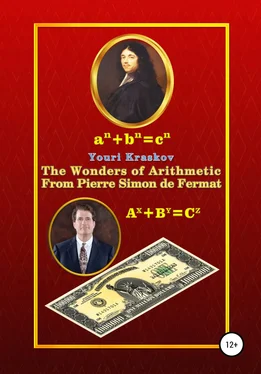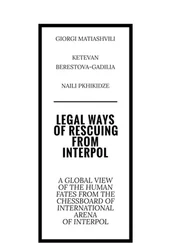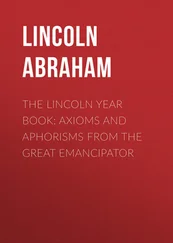It is even difficult to imagine how these critics would have been amazed to find out that in fact Fermat had never dealt with the search for this proof since at that time he could not know what exactly is to be proven. But namely in the last sentence of the FLT wording, which had so much outraged them, there is a keyword directly indicated how he have solved this problem. It so happened that for centuries the science world vainly tormented itself in search of the FLT proof, but Fermat himself was never looked for it and simply had declared that he had it discovered! 13 13 The text of the last FLT phrase: “ I have discovered a truly amazing proof to this, but these margins are too narrow to put it here ”, obviously does not belong to the essence of the theorem, but for many mathematicians it looks so defiant that they tried in every way to show that it's just empty a Gascon boasting. At the same time, they did not notice neither humor about the margins nor the keyword “discovered”, which is clearly not appropriate here. More appropriated words here could be, say, “obtained” or “founded”. If Fermat’s opponents paid attention to this, it would become clear to them that the word “discovered” indicates that he received the proof unexpectedly by solving the Diophantus' task, to which a remark was written called the FLT. Thus, mathematicians have unsuccessfully searched during the centuries for FLT proof instead of looking for a solution to the Diophantus' task of decomposing a square into the sum of two square. It seemed to them that the of Diophantus' task was clearly not worth their attention. But for Fermat it became perhaps the most difficult of all with it he has worked on, and when he did cope with it, then received the discovery of the FLT proof as a reward.
It is possible also to remind to opponents ingeminating about Fermat’s deliberate refusal to publish his works that for example, Descartes had received permission to publishing from Most Reverend cardinal Richelieu himself. It was impossible for Fermat and there is even a written (!!!) testimony about it (see text on P. Fermat’s tombstone: “Vir ostentationis expers … – He was deprived the possibility of publication …”. See Appendix VI Pic. 93 – 94). Nevertheless, even being in such conditions, he had prepared the publication of Diophantus’ “Arithmetic” with the addition of his 48 comments, one of which got a name the “Fermat’s Last Theorem”.
The publication was supposed to appear in honor of the historically significant event – the foundation of the French Academy of Sciences, in which preparation Fermat himself participated through the correspondence with his long-time colleague from the Toulouse parliament Pierre de Carcavy who became the royal librarian. The royal decree of the creation of the French Academy of Sciences was prepared by Carcavy and the all-powerful Finance Minister Jean-Baptiste Colbert submitting it to the signing by Louis XIV. However, the Academy of Sciences was established only in 1666 i.e. a year after the Fermat's death.
Mathematicians are very famous for how they are strict pedants, formalists and quibblers, but as soon as it comes to the FLT, all these qualities immediately disappear somewhere. Fermat's opponents ignoring well-known facts, called him either a hermit (this is a senator from Toulouse!) or a prince of amateurs (this is one of the founders of the French Academy of Sciences!), and this despite his contribution to science comparable to its importance only with a couple or triple of the most prominent scientists in the history of science!
They also did not fail sarcastically to point out that no one would have known about Fermat if the greatest mathematician of all times and peoples Leonhard Euler had not become interested in his tasks. But just this magic name has played a cruel joke with them. Their boundless belief in Euler's innovatory researches was too blind to notice that it was namely thanks to him science received such a powerful blow, from which it cannot recover up to now!
Mathematicians not only have believed Euler, but also warmly supported him that algebra is the main mathematical science, while arithmetic is only one of its elementary sections. 14 14 It is curious that the Russian-language edition this fundamental work of Euler was published in 1768 under the title "Universal Arithmetic" although the original name "Vollständige Anleitung zur Algebra" should be translated as the Complete Introduction to Algebra. Apparently, translators (students Peter Inokhodtsev and Ivan Yudin) reasonably believed that the equations are studied here mainly from the point of view of their solutions in integers or rational numbers i.e. by arithmetic methods. For today's reader this 2-volume edition is presented as a Chinese literacy because along with the highly outdated Russian language and spelling, there is simply an incredible number of typos. It is unlikely that today's RAS as the heiress of the Imperial Academy of Sciences, which published this work, understands its true value, otherwise it would have been reprinted a long time ago in a modern and accessible form.
Euler's idea was really excellent because his algebra, which gained new possibilities through the use of "complex numbers" was to be a most powerful scientific breakthrough that would allow not only to expand the range of numbers from the number axis to the number plane, but also to reduce the most of all calculations to solving algebraic equations. 15 15 Here there is an analogy between algebra and the analytic geometry of Descartes and Fermat, which looks more universal than the Euclidean geometry. Nevertheless, Euclidean arithmetic and geometry are the only the foundations, on which algebra and analytical geometry can appear. In this sense, the idea of Euler to consider all calculations through the prism of algebra is knowingly flawed. But his logic was completely different. He understood that if science develops only by increasing the variety of equations, which it is capable to solve, then sooner or later it will reach a dead end. And in this sense, his research was of great value for science. Another thing is that their algebraic form was perceived as the main way of development, and this later led to devastating consequences.
The need for "complex numbers" mathematicians explained very simply. To solve absolutely any algebraic equations, you need (not so much!) to make the equation x 2+ 1 = 0 become solvable. 16 16 Just here is the concept of a “number plane” appears, where real numbers are located along the x axis, and imaginary numbers along the y axis i.e. the same real, only multiplied by the “number” i = √-1. But along that come a contradiction between these axes – on the real axis, the factor 1 n is neutral, but on the imaginary axis no, however this does not agree with the basic properties of numbers. If the “number” i is already entered, then it must be present on both axes, but then there is no sense in introducing the second axis. So, it turns out that from the point of view of the basic properties of numbers, the ephemeral creation in the form of a number plane is a complete nonsense.
In Russian this is called: "Don’t sew the tail to a mare"! This equation is not at all harmless since it has nothing to do with practical tasks, but undermines the fundamentals of science very substantially. Nevertheless, the devilish temptation to create something very spectacular on empty place turned out to be stronger than common sense and Euler decided to demonstrate the new mathematical possibilities in practice.
Pic. 16. Leonhard Euler

The FLT, which Euler could not to prove, would be perfect for demonstrating the possibilities of a new wonder-algebra. However, the result turned out to be more than modest. Instead of a general proof of FLT, only one particular case for the 3rd power was proven [8, 30]. More ambitious was seemed the proof of other Fermat’s theorem about the only solution in integers of the equation y 3= x 2+ 2 [36] because it was a very difficult task and like FLT, none of the mathematicians could solve it. Despite the fact that the very possibility of solvability of any algebraic equation has not yet been proven, these Euler's demonstrations were perceived by hurrah. It only remained to find a solution to the problem called the “Basic Theorem of Algebra”. In 1799 the real titan of science Carl Gauss coped brilliantly with this task presenting proof even in 4 different ways!
Читать дальше






![Theresa Cheung - The Dream Dictionary from A to Z [Revised edition] - The Ultimate A–Z to Interpret the Secrets of Your Dreams](/books/692092/theresa-cheung-the-dream-dictionary-from-a-to-z-r-thumb.webp)






